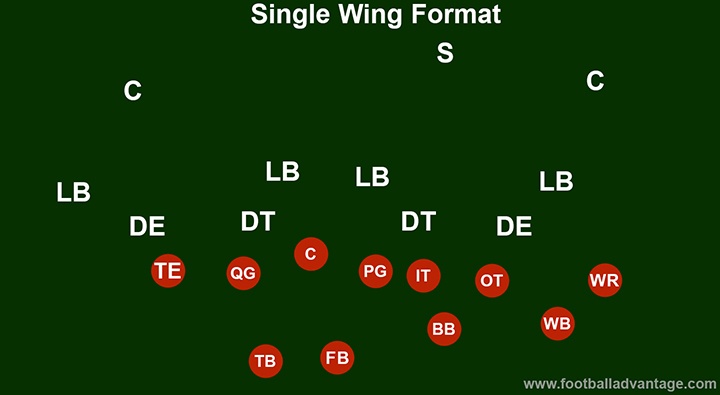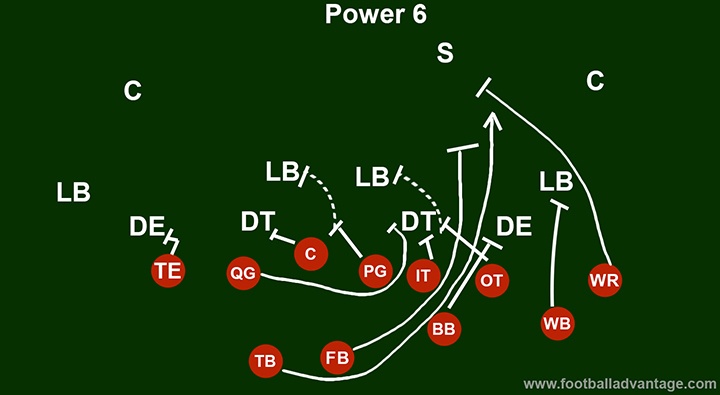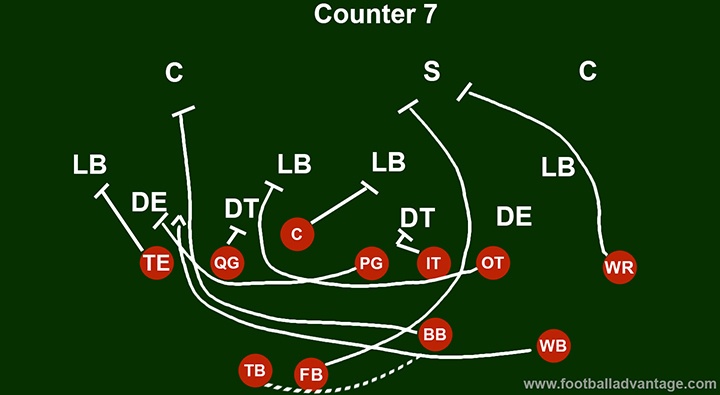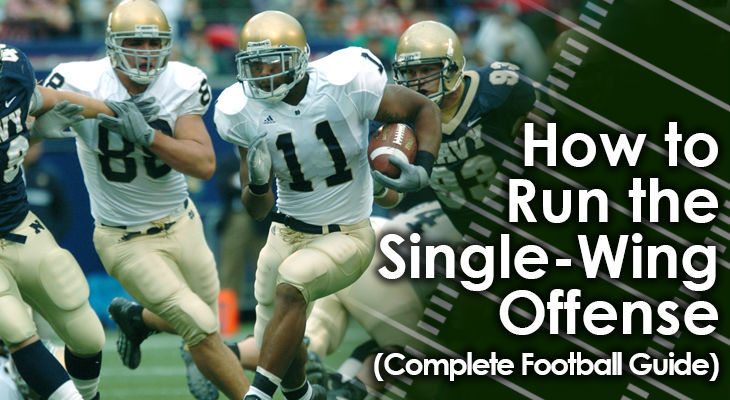The single-wing offense was one of the first true offensive formations in American football.
It was created by the legendary Pop Warner.
(That’s the same Pop Warner that youth football leagues around the country were named after.)
This offense dominated offensive playbooks of teams at every level of football for many years.
Then, slowly by surely, the single-wing offense fell from popularity.
Especially at the professional and collegiate levels of the game when offenses began to add a lot more passing plays into their plan of attack.
As quarterbacks began to mold into the pocket passers that we see today, and defenses grew bigger and faster as well, the single-wing offense went by the wayside.
Influences of the offense can still be seen today in the pros and college ranks with the spread formation…
But for the most part, no one runs a true single-wing offense at those levels.
However, it’s still a popular offensive formation in high school and youth football ranks because teams at these levels are more focused on running the football in a smash-mouth style than they are implementing a passing game.
Who Should Use the Single-Wing Offense?
- Teams who lack a true pocket-passing quarterback who has a strong arm and can throw the ball all over the field.
- Teams who have extra offensive linemen worthy of starting, including multiple tight ends.
- Teams who have multiple running backs and a receiver who are strong in the blocking game.
- Teams that are looking to create confusion for opposing defenses who have to identify different blocking attacks and ball carriers every play.
Who Should Not Use the Single-Wing Offense?
- Teams that have a lot of skilled wide receivers and a traditional quarterback.
- Teams that don’t have a lot of big bodies up front who can block.
- Teams that don’t have the backs and receivers who are able to block very well.
- Teams who aren’t good at blocking overall because plays run out of the single-wing won’t be successful if even one player on the team misses a blocking assignment.
Single-Wing Offense Personnel:
We’ll start our breakdown of the single-wing offense by discussing the personnel involved.
Because as you’ll soon see, it is a unique formation that is unlike most other offensive formations in football.
As we mentioned before, a traditional quarterback is not essential for a successful single-wing offense. In fact, we won’t even label a player as the quarterback in this offense.
Here is the breakdown of personnel for a single-wing offense:
Backfield:
- Tailback (TB)
- Fullback (FB)
- Blocking Back (BB)
- Wing Back (WB)
Offensive Line:
- Tight End (TE)
- Quick Guard (QG)
- Power Guard (PG)
- Inside Tackle (IT)
- Outside Tackle (OT)
- Center (C)
Wide Receivers:
Single-Wing Offense Formation
The pre-snap formation of a single-wing offense will look a lot different than most offenses that you’ll see.
While there will be the typical six offensive linemen in a single-wing, where they line up – and what their responsibilities are – are very unique.

Center (C) - Starts over the ball in his normal position.
Quick Guard (QG) - Starts on the weak side of the formation, with the tight end to his outside.
Power Guard (PG) - Starts on the other side of the center, toward the strong side of the formation.
Tight End (TE) - Will seal off the defensive end on the weak side of the field.
Inside Tackle (IT) - Starts on the outside of the PG.
Outside Tackle (OT) - Starts on the outside of the IT.
Wide Receiver (WR) - Starts on the outside on the strong side of the offense
Tailback (TB) - Starts in a shotgun formation slight to the left or right of the center
Fullback (FB) - Starts to the TB’s right or left, also in shotgun formation.
Blocking Back (BB) - Starts in the backfield almost directly behind the inside tackle. This position in the formation will keep the blocking back hidden from defenders, as he is shielded by the bigger body of the inside tackle in front of him.
Wing Back (WB) - Will line up in the backfield on the strong side of the offense outside of the outside tackle, almost on a diagonal from his position. Similar to the blocking back, the wing back’s position in the formation will keep him hidden slightly from the opposing defenders.
In regards to the Tailback and Fullback…
Their alignment is done to confuse the defense, as the center will have the ability to snap the ball to either player, depending on what play is called.
In most cases, the tailback will be the player who handles the snap, but the fullback could also take the snap on some plays to create confusion on a misdirection play.
2 Single-Wing Offense Plays
Most of the plays called out of a single-wing formation will be running plays.
But that doesn’t mean the offense will be boring.
In fact, the beauty of the single-wing offense is that many different running plays can be called out of the formation, with the idea being that the more confusion an offense can create, the better.
Here, we’ll talk about two common plays that are called out of the single-wing offense.
One that is a classic running play (Power 6) and one that involves misdirection (Counter 7).
These plays could be called something slightly different based on a specific offense’s terminology.
Power 6 Play
The Power 6 is a single-wing play that involves running the ball to the strong side of the formation.
The idea of this play is to have the tail back take the snap and follow his blockers to hopefully run upfield in the direction of the inside tackle.
For each blocking assignment, each position will be asked to block down on their player toward the weak-side sideline so that the hole can open up on the other side of the field.

The assignments for each player along the line of scrimmage in the Power 6 play are:
Center (C) - Will block down on the defensive tackle lined up to his left.
Power Guard (PG) - Will block down on the inside linebacker who is lined up over the center.
Inside Tackle (IT) - Will block down on the defensive tackle lined up across from him.
Outside Tackle (OT) - Will chip on the defensive tackle opposite the IT and then will peel off to block the other inside linebacker at the next level.
Wide Receiver (WR) - Will move downfield on the outside and pick up the strong safety, who will be approaching the line of scrimmage.
Tight End (TE) - Will seal off the defensive end on the weak side of the field.
Quick Guard (QG) - Will pull behind the center and turn up field to the right of the Power Guard to help with blocking whatever defender enters that zone.
Blocking Back (BB) - Will wait until the outside tackle passes in front of him, and then attack forward to block the strong-side defensive end, pushing him toward the sideline as much as possible.
Wing Back (WB) - Will have responsibility for sealing off the outside linebacker on his side of the field in the same fashion.
Fullback (FB) - Will be the lead blocker for the tailback. The fullback will run toward the hole the offensive line has hopefully created and will pick up whatever defender first gets in his way, preventing that defender from getting to the ball-carrying tail back.
Tailback (TB) - Will take the snap of the ball from center, identify the open hole and run/cut toward it to gain as many yards as possible.
Counter 7 Play
The Counter 7 is a misdirection play that is designed to cause a lot of confusion.
In essence, it’s a play that will hopefully get the defenders attacking toward the strong side of the offense before the tailback reverses field to the weak side by handing the ball off to the wing back.
To do this, the pulling offensive linemen will happen from the other side of the field as in the Power 6.

The assignments for each player along the line of scrimmage in the Counter 7 play are:
Tight End (TE) - Will block the outside linebacker on his side of the field, sealing him off toward the sideline.
Quick Guard (QG) - Will block down on the weak-side defensive tackle, pushing him toward the middle of the field.
Center (C) - Will be responsible for blocking the inside linebacker on the strong side of the field.
Inside Tackle (IT) - Will seal off the defensive tackle on his side of the field.
Power Guard (PG) - Will pull behind the center and quick guard to seal off the weak-side defensive end.
Outside Tackle (OT) - Will follow the power guard, but will turn upfield just outside the center’s original position in the formation, and be responsible for blocking the inside linebacker who lined up on the weak side of the offense.
Wide Receiver (WR) - Will be responsible for getting downfield to seal off the attacking strong safety.
Blocking Back (BB) - Will serve as the lead blocker on this play. He will travel in the backfield toward the weak side of the offense, turning up field once he hits the original position of the quick guard.
Fullback (FB) - Will act as a bit of a decoy. He will act as if he is the lead back for the tailback, running toward a hole on the strong side of the offense. However, once he breaks through the line of scrimmage, he should get downfield to assist in blocking any defenders who break free.
Tailback (TB) - Will receive the snap from the center and run toward the strong side of the defense as if he were going to be running the ball. But instead of doing so, he will hand off the ball to the wing back who will be following the blocking back toward the weak side of the offense.
Wing Back (WB) - Will take the hand-off from the tail back and follow the blocking back to the weak side of the offense, turning up field when he identifies the open hole the blockers have created.
Conclusion
The single-wing offense might not be as popular at the collegiate and professional levels of football nowadays, but it’s still an offense that could be used quite successfully at the youth level.
If your team doesn’t have a traditional passing quarterback, and if it has a lot of players who are good at blocking, then the single-wing might be a good option for your team.
Don’t let the single-wing’s focus on running the football scare you away, though…
It’s still an offense that creates a lot of confusion and misdirection.




